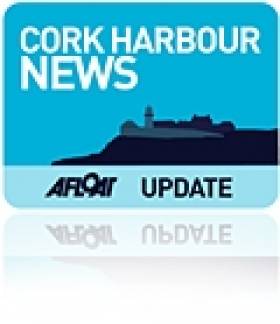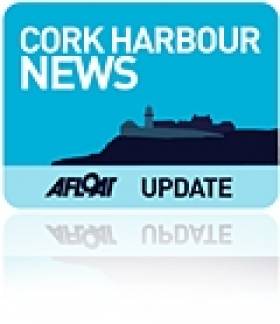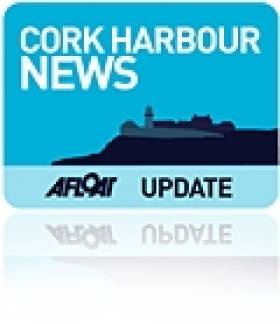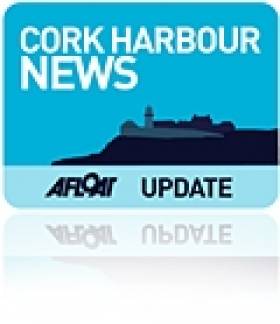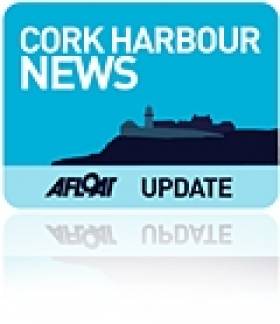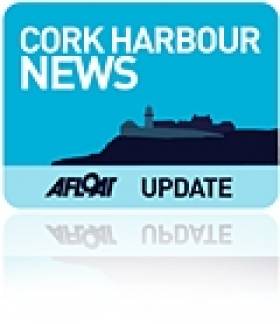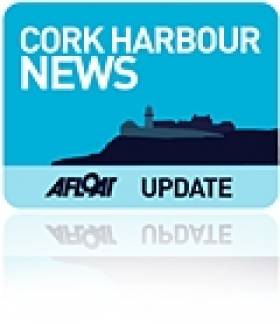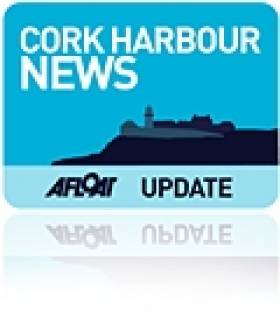Displaying items by tag: Cork Harbour News
Cork Harbour to Get €1bn Makeover into 'Sydney of Europe'
#CorkMakeover - In an image published on the Irish Independent (click here), this is what Cork harbour will look after a massive €1bn makeover that will transform it from an industrial eyesore, into one of the world's great maritime and tourism centres.
Cork ranks as one of the world's five great natural harbours and, in the 19th century, was arguably the most important port for Britain's Royal Navy as it controlled the Atlantic approaches.
In the early 20th century, Cork harbour was also one of the world's busiest cruise liner ports and was associated with such famous ships as RMS Titanic, RMS Lusitania and HMS Dreadnought.
Cobh Harbour was the last mooring of the Titanic before she set sail for the open Atlantic in 1912,never to return. The White Star Line office, where tickets were bought for the ill-fated sailing, is now a museum and heritage centre based around the massive liner.
But over 100 years of under-investment and problematic industrial projects has left Cork with a depressing harbour legacy. For more on this story, click HERE.
Conference at IMERC: Cork Harbour – Energising the Region
#IMERCconference - Energy Cork and Irish Maritime Energy Resource Centre (IMERC) are to host a major one-day conference 'Energising the Region' next month in the National Maritime College of Ireland.
The conference on Friday 12 December, is to acknowledge and celebrate Cork Harbour in particular its unique role in national energy supply and innovation in addition to our environment, energy, commercial and tourism landscape in Ireland.
Vibrant, panoramic, dynamic, scenic, productive, clean and powerful are just some of the ways to describe Ireland's greatest natural resource and one of the world's largest and most unique ports - Cork Harbour.
From the historic legacy of a trading centre to today's modern port, Cork Harbour is a world-class model of how industry, energy, tourism and leisure can not only exist in harmony together, but thrive in their co-existence through vision, collaboration and community.
Speakers will include:
Minister for Agriculture, Marine and Defence Simon Coveney TD
John Mullins, Chairman of Port of Cork
John Killeen, Chair of Galway Volvo Ocean Race Group
Gordon McIntosh, Director of Enterprise, Planning and Infrastructure, Aberdeen City Council
Energising the Region is a free conference (registration is essential) and will take place at the National Maritime College of Ireland (NMMI) Ringaskiddy from 0830 – 1330 on Friday 12th December.
To register and for a ticket visit this LINK and for a brochure and full agenda, click HERE.
#IrishShipping@VCD – Irish Shipping Ltd had vessels built in the UK, outside Europe and notably during the tenure of Verolme Cork Dockyard which launched larger vessels before the 1984 closure of the company, writes Jehan Ashmore.
It should be also noted when ISL was formed in 1941, this included taking on the abandoned Cork dock 'yard' that was Rushbrooke Dockyard, where such facilities date to 1853. The yard allowed their ships to be repaired at the newly created Cork Dockyard Ltd.
The yard would change hands in 1959 as ISL invited Dutch shipping magnet Cornelius Verolme to purchase the dockyard and develop the Irish shipbuilding industry. Under the leadership of Verolme, 33 vessels were launched for various owners from the yard that at its peak employed 1,500 workers. For 25 years shipbuilding and offshore installations took place at the yard until its closure in 1984.
More than a decade later, the yard site was purchased in 1995 by the Burke Group. The 44-acre facility was reopened under the same name of Cork Dockyard Ltd running as a ship-repairer, engineering and fabrication business.
In the year before ISL's collapse, V.C.D. built the 'Panamax' bulk-carrier Irish Spruce. At almost 72,000dwt /40,000grt, she was easily the largest ever ISL ship built. In 1983 she was launched down the slipway at Rushbrooke onto the River Lee.
According to 'Irish Shipping Ltd- A Fleet History' (published in 2013) the chapter on the bulker gives the following principle dimensions: length 226m, breath 32.5m and a draught of 14.3m. She had 7 self-cleating McGregor holds. Her superstructure of bridge, accommodation and facilities was designed to a very high standard.
The order to have Irish Spruce built in Ireland was placed by a subsidiary of ISL, which itself was a state-owned company. The decision by the Irish Government at the time was controversial given the option of a far cheaper alternative from a Japanese yard. The decision proved costly, as the shipping company was already under financial burden.
Despite management and politics, Irish Spruce from a maritime perspective presented an impressive example of Irish shipbuilding skills, however she had the indignity of been laid-up under arrest in Marseilles when the company got into troubled waters.
The final ship from V.C.D. was the HPV L.E. Eithne (P31) ordered by the Department of Defence for the Naval Service and launched in 1984. The helicopter carrying HPV represented the last large ship completed in a major yard within the republic.
Last year during the national 'Gathering', events as previously reported commemorated Cork's shipbuilding heritage and workers. Centre-stage to this era of ship construction was the former shipyard of V.C.D.
‘Open Day’ at the National Maritime College of Ireland
#OpenDay@NMCI – An 'Open Day' at the National Maritime College of Ireland (NMCI), Europe's only purpose built maritime education college which celebrated its 10th anniversary earlier this month, is to be held on Tuesday 21 October.
Times for the Open Day are 10am-3pm. Visitors can take tours to view the impressive facilities located at the campus in Ringsakiddy, Cork Harbour.
The world class maritime education and training centre at NMCI became the first third level college in the country to be built under the Government's Public-Private Partnership scheme.
NMCI is a constituent college of CIT and brings together the Irish Naval Service and Merchant Marine under one roof in one of the most advanced maritime academies of its type in the world.
For further information about the Open Day, enquiries and bookings for large groups contact NMCI Tel: (021) 433 5607 by email: [email protected] and for more visit the website: www.nmci.ie
#LuxuryExpeditionYacht – Seawolf, a 58m five-star luxury adventure expedition superyacht, once known as the hardest working ocean-going tug in the world called to Cork City quays this morning, writes Jehan Ashmore.
The 850 tonnes luxury vessel converted from the tug Smit Clyde launched in the Netherlands in 1957 had sailed overnight from Glengariff, the attractive anchorage that is also drawing a rising number of cruiseship callers.
During her days as Smit Clyde the vessel's global towage career proved her worth through a combination of strength and endurance that would gain her the respect and admiration of mariners worldwide.
A notable long-distance tow was that of simultaneous tow of two United States Navy aircraft carriers from Boston to Japan in 1968.
Due to her size, Seawolf which has three decks of luxurious facilities having been completely redesigned and rebuilt in 2002 docked along North Custom Quay rather than the adjacent Cork City Marina, from where the 38m motoryacht Katrion paid a call earlier in the summer.
Seawolf which had an overhaul in 2009 has accommodation for 12 guests that consists of a master VIP double, 6 staterooms, double and single twins. This is four more guests than Katrion which for the last month has remained in Dublin Port berthed at the Poolbeg Yacht & Boat Club Marina though she is understood to be departing tomorrow.
As to be expected of an adventure ship, she carries an array of tender craft and leisure toys to choose between. There are kayaks, a 29ft Hereschoff sailboat, a pair of Optima sailboats, wind surfers, adult and children's wake board & water skis, scuba equipment. Plus should anyone fancy trying out some sports fishing tackle that's included.
She has a speed of 12 knots and this is delivered from a JK Smit-Man engine and generators (2 x Scania 220kw and a single Scania 260kw). A 12,000 nautical mile range is achieved by consuming 22,000 litres of fuel.
Also sharing North Custom Quay is appropriately the tug Celtic Isle. The 31m Irish-flagged 400 tonnes vessel built in Japan is operated by the Cork based Mainport Group.
US Training Ships Mark New and Old Ties with Cork Harbour
#UStrainingShips - A pair of US training vessels, one under sail the other motor-propelled have made new and continued old ties with Cork Harbour, writes Jehan Ashmore.
Following a transatlantic sail from the US East coast, the SSV Corwith Cramer which as previously reported made her first visit to Cork City is berthed at the marina and was made open to the public yesterday.
The 1988 built sail training vessel belongs to the Sea Education Association (SEA) and the school ship will spend over a week on the river Lee. She is expected to depart next Sunday and continue her first visit to ports on the European mainland.
Meanwhile, the other US vessel reported earlier is the veteran merchant training ship T.S. Empire State (1962/14,557grt) which has been berthed in lower Cork Harbour at Cobh has since departed.
Having said that, the former general-cargoship now a training ship of the Maritime College of the State University College of New York (SUNY) remains currently at anchor off Cork Harbour.
The ship has made Cork her Irish port of call on several occasions in addition to Dublin. Her cadets are preparing to embark on the next leg of her annual Summer Sea Term where the Danish capital of Copenhagen is her next port of call.
#LuxuryFeadship - A luxury motoryacht the Katrion (2003/401grt) is berthed at Cork City Marina, the 10-guest, 38.6m Feadship built vessel is advertised for sale for just shy of €13m, writes Jehan Ashmore.
The Cayman Islands flagged Feadship, a Dutch yard with more than 250 superyachts launched, has been in port for around a week though it is understood the motoryacht completed in 2003 is to head to Dingle.
Visitors such as the size of Katrion are accommodated on the outside berth of the Cork City Marina pontoon, where larger craft drawing up to 4m are moored alongside. The handsome and well proportioned-looking visitor (click for further details) has a draft of 2.5m.
Cork City Marina has 150m length of berthage which occupies an area between South Custom House Quay and Albert Quay. At the adjoining quay heading downriver are the more frequently used South Jetties from where commercial shipping docks close to the city-centre.
An example is Arklow Fortune (2007/2,998grt), which today is berthed at the privately owned quayside which mainly is used for grain imports to supply the nearby silos.
Other merchant vessels can also berth on the far side along the northern channel of the River Lee, though such activity is moreso for visiting vessels, among them Naval ships or those requiring lay-over periods.
One of the largest ships in recent years to berth along this stretch was at Horgan Quay, where Fastnet Line's Julia, the former Cork-Swansea car-ferry was moored in advance to starting the Welsh link. Currently she serves as a floating accommodation ship for a wind-farm installation off Cumbria.
#TrainingShip – Veteran US merchant training ship T.S. Empire State (1962/14,557grt) arrived into Cork Harbour this morning, the Irish port forming one of several European ports of call as part of an annual Summer Sea Term, writes Jehan Ashmore.
The former general cargo vessel crossed the Atlantic Ocean, where around 500 male and female cadets from the Maritime College of the State University College of New York (SUNY) will get hands-on experience to learn seafaring skills to compliment their classroom based studies.
This year's Summer Sea Term involves calls to ports in U.S. East coast ports, Portugal, Canary Islands and Denmark. The voyage will provide an opportunity to visit Western Europe and exposure to cultures overseas.
The cadets at SUNY Maritime enroll for four-years at the college which offers undergraduate and graduate degrees.
Launched in 1961, the Empire State was laid down originally as the general cargos ship SS Oregon at Newport News Shipbuilding and Drydock Company in Virginia. Her career began with States Steamship Company for service in the Pacific trades.
In design terms, her era is reflected through her classic hull form lines, cargo derricks and large superstructure compared to her modern container counterparts.
For further details of the ships interim career prior to her current role in which she has served since 1990, click this Link.
Empire State is no stranger to Irish ports as last year's Sea Term included Dublin Port. Her arrival today to Cobh, where the majority of cruise ships berth will provide something different for onlookers to witness.
#CorkDockyard – Following a previous snap-shot of Cork Dockyard, which focused on L.E. Eithne, the quays of the ship-repairs and maintenance facility is also where a coastal tanker and a seismic support vessel are berthed, writes Jehan Ashmore.
The 4,972dwt products tanker Forth Fisher belongs to Cumbrian based James Fisher Everard. She along with sister Galway Fisher which was also in Cork Harbour having anchored off Cobh yesterday beyond the Spit Bank lighthouse.
The pair are frequent callers along with other fleetmates to the Whitegate Oil Refinery, transporting cargoes to the ports along the west coast including Galway Harbour.
Further downriver at Cork Dockyard, the seismic support vessel, Mainport Elm, which is a type of vessel used to conduct surveys for the energy and exploration industry.
The Marshall Islands flagged vessel is part of a fleet of seismic vessels including tugs operated by Cork based Mainport Group, which also has the contract to serve the Kinsale Gas Field carried out by the multi-role support vessel Pearl.
In 2011, Mainport signed for their first purpose built seismic support vessel from the Piasau Shipyard in Miri Malaysia which completed Mainport Cedar a year later. In 2013 she was delivered straight into a charter service.
Seismic survey ship, Mainport Elm also berthed at Cork Dockyard. Photo: Jehan Ashmore
A sister also followed, Mainport Pine with keel-laying taken place in 2012 and delivered earlier this year. Likewise of her sister, she was placed directly into charter service.
In recent years, there has been more oil and gas exploration activity off the south and west coasts, in which Cork Harbour's strategic location has served as a base.
As previously reported, an example to the type of vessel supporting the sector was Bourbon Clear, a platform supply vessel (PSV) which docked in Ringaskiddy last year.
#CorkDockyard – Among the shipping seen at Cork Dockyard yesterday was the Naval Service 'flagship' L.E. Eithne (P31) which was berthed in the graving dock, writes Jehan Ashmore.
The Helicopter Patrol Vessel (HPV) is at the shipyard and repair facility where on the same site at a neighbouring slipway she was launched three decades ago from Verolme Cork Dockyard (VCD). She along with L.E. Aoife (P22) and L.E. Aisling (P23) were built by VCD, they were commissioned into service in 1979 and 1980 respectively.
L.E.Eithne represents the last custom built patrol vessel for the Naval Service from that of the VCD yard and notably the last ever ship completed in the republic in 1984. As previously reported on Afloat.ie, as part of last year's The Gathering, a commemoration of Cork's shipybuilding workers and heritage over 160 years was held in Cobh.
Shipbuilding in Cork Harbour has long gone, however on the far side of the Celtic Sea, it is pleasing to note of the third option to build another Naval Service OPV90 class was confirmed by An Taoiseach, Enda Kenny T.D. and Minister for Defence with the same yard of Babcock Marine in north Devon.
The contract of the €54m newbuild follows the class leadship, L.E. Samuel Beckett (P61) and sister L.E. James Joyce currently under construction at the yard in Appledore and due in early 2015.
The third 'playright' OPV90 sister is expected to be delivered into service in 2016.



























